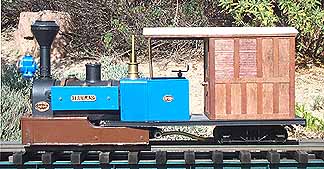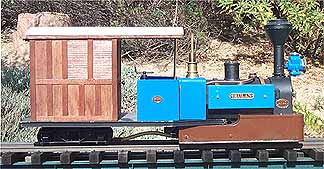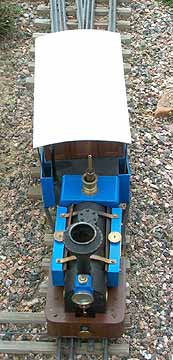
Back to Sidestreet Bannerworks
October 2002
Graham Stowell's Irulan
by Marc Horovitz

Of all the engines in my collection, this is one of the most unusual, for a variety of reasons. The prototype was one of five engines built by Hunslet for the Lagos Steam Tramway. The originals pulled four-wheel carriages. The model, though, is without couplers. A book on the line, The Lagos Steam Tramway 1902-1933 by Nevil Miller, was published in 1958 by W.J.Fowler, London. (Thanks to Sam Evans and Jim Wild for bringing this to my attention.)
The model was built by Graham Stowell of England from a Mamod 0-4-0T. It is estimated that somewhere around 30,000 Mamod locomotives have been made, and a goodly number have been fodder for kitbashers' creativity. Such was the fate of this particular engine. Graham is a prolific builder and kitbasher, one with a peculiar turn of mind. Whimsy, often of a startling nature, is incorporated into much of his work. I suspect he was attracted to this particular prototype because of its own inherent whimsy.
Anyway, Graham built a beautiful little trailer out of wood and metal to go behind the engine, while modifying the locomotive to suit. The trailer is supported by an interesting harness arrangement that hinges on the locomotive's frame above and between the drivers. A proper alcohol burner replaced the horrible pellet burner, and the fuel tank is cleverly built into the trailer's truck. An Enots valve* was fitted to the engine so that the boiler could be refilled with a squirt bottle while the engine is under steam. There's a Mamod-type water glass in the back of the boiler.
The main body of the locomotive is painted a lurid blue, as were all of Graham's locomotives from this era. Also, as with all his other engines, it is named after some significant person, place, or thing from Frank Herbert's Dune series. If nothing else, this locomotive is charming, and is a favorite of mine.
* "Enots" is the word "stone" spelled backwards. It was used as the trading name for a company called Benson and Stone, who first developed the Enots range of fittings for thier lubrication systems. —Thanks to Mark Rose for this information
The run
The last time Irulan was run, its performance was poor. The problem was diagnosed as wheels that had come loose on their axle, a common malady with Mamod locomotives. To make even the most rudimentary repair to this machine required significant disassembly of the engine, which I wasn't in the mood for at the time, so I replaced it on the shelf.
However, now seemed a good time to have a go at it. Although repair work is not a thing I normally like to do, deeply probing the viscera of someone else's creation is often enlightening. It offers a glimpse into another man's mind, and the view is not always comforting.
Graham Stowell, for all his eccentricities, is ingenious in his work. It took a fair amount of study for me just to understand how the engine went together. However, once this understanding was bestowed, the work went forward. The skirt, a main obstacle, was first removed. When Mamod wheels let go, the first thing to try is restaking them to the axle, which I did. When this didn't work (it rarely does), I went rooting in the scrap box and unearthed a brand-new pair of 0-gauge Mamod drivers. To install them required fairly extensive dismantling of the engine. The frames had to be brought in toward one another so that the old wheelsets could be lifted out and the new ones installed. This was ultimately accomplished and the locomotive was restored to its original condition, ready for a go on the track.
Irulan was prepared for duty in the usual way. The engine was set on the concrete bridge I often use for steaming up and the fire was lit. I went off to do a little track cleaning. When I returned, a large patch of groundcover beneath the engine was ablaze. The burner had overflowed a little, dripping meths and fire on the greenery below. Oh, well. Once the fire was out and steam was up, I opened the throttle and the engine trundled off beautifully.
The motion of the pistons imparts a side-to-side action to small locomotives, particularly four-wheelers, called boxing or hunting. This motion was small on the locomotive itself, but was magnified by the time it got to the trailer, which bobbed down the track in a most amusing way. The run lasted around 10 minutes or so, which is adequate for a Mamod loco. Water and fuel could have been added at any time, keeping the engine in steam indefinitely. I was quite pleased with the engine's performance and doubly so that the wheels stayed firmly fixed to their axles.
|
|
|
| Builder | Graham Stowell / Mamod (England) |
| Date built | 1991 |
| Gauge | 32mm (gauge 0) |
| Scale | 16mm |
| Boiler | Pot |
| Fittings | Safety valve, water, glass, throttle/reversing valve, ENOTS water-filler |
| Fuel | Alcohol |
| Blow-off pressure | 15 psi |
| Cylinders | Two double-acting oscillators |
| Reversing gear | Rotary reversing valve |
| Lubricator | None |
| Dimensions | Length, 13-5/8"; width, 4"; height, 6-1/4" |




Above: The filler pipe from the ENOTS valve into the boiler.
Right: The rear of the wooden carriage.

Right. You can see how the unit articulates going around a curve.
Below: Meths is carried in the tank in the rear truck.


Back to Sidestreet Bannerworks
This page and its contents Copyright Sidestreet Bannerworks, 2002